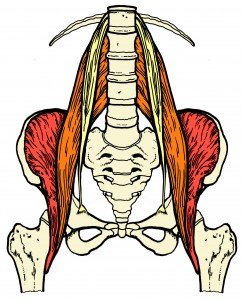 While the psoas muscle might not be the cause of all of your lower back pain it is invariably involved in some way or another in pretty much every incidence of lumbar spine and lower back problems.
While the psoas muscle might not be the cause of all of your lower back pain it is invariably involved in some way or another in pretty much every incidence of lumbar spine and lower back problems.
As the psoas is the only muscle connecting the legs to the spine above the pelvis it would be difficult for this not to be the case.
I often return to the idea that the psoas is the body’s most important muscle for three reasons.
- The psoas muscle helps us stand upright which is kind of key to being human.
- It walks us through life as the muscle that initiates each successful step we take.
- It gets interesting when we consider the psoas to be the warehouse of the body’s unprocessed energy and trauma.
All three of these concepts revolve around the lumbar spine along which the psoas attaches, and actually creates when we first come up to stand.
If the spine suffers the psoas suffers so it doesn’t matter which of the following issues someone might be dealing with, the psoas will be affected.
Here are some more bullets covering some spine and disc issues, though back pain isn’t exclusive to this club:
- Stenosis
- Herniation’s
- Spondylosis
- Spondylolysis
- Spondylolisthesis
The psoas attaches at six points—one below the pelvis and five above.
Below the pelvis, the psoas inserts with the iliacus, as they form a common tendon, onto the lesser trochanter at the back of the femur bone.
Above, the psoas originates from the bodies and the bases of the transverse processes of the 12th thoracic vertebrae through the fourth lumbar vertebrae (T12-L4).
The bones of the lumbar spine are meant to stack one on top of the other. They are big fat bones that bear weight and allow for very little rotational movement.
Any of the above conditions— and there are others that could be added to the list— will mess with the ideal alignment of the bones which will throw off the ideal alignment of the psoas.
A well-aligned psoas supports the lift and extension of the entire spine. A well-aligned psoas can limit the chances of these types of degenerative issues occurring or worsening.
But unfortunately the reverse is true as well. As disks degenerate for whatever reason their movement or calcification can disable the psoas ability to function fully and efficiently as the attachment at each of the vertebrae influences the others.
My recipe for supporting these issues has four ingredients so here are some more bullets:
- Release your psoas
- Improve your posture
- Develop balanced core tone
- Find better movement patterns.
